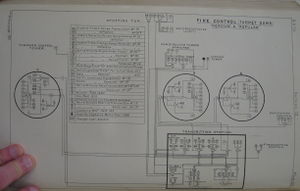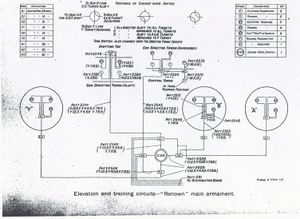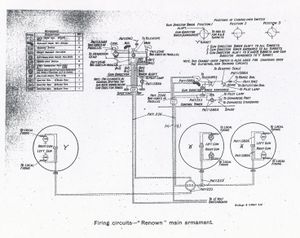Renown Class Battlecruiser (1916)
Armament
Guns
Torpedoes
2 Service Bar 21-in submerged broadside tubes forward depressed 2 degrees and bearing 90.[1]
These could not be fired at speeds over 31 knots, as the bar would bend.[2]
Fire Control
Phones
Main Battery
Secondary Battery
Each 4-in triple mounting had a Pattern 3333 Navyphone for its officer, and a set of Pattern 3225 Telaupad receivers for each of its three sightsetters. The single 4-in guns were similar, but with a single telaupad receiver for the sightsetter. The 4-in TS had a pair of Pattern 3334 Navyphones plugged into its exchange board.[3]
Other remote stations from the TS's exchange board were:
- One Pattern 3331 Navyphone in 15-in GCT
- Two 3334s (apparently teed off from each other in a junction box) in each of
- Forward night defence position
- Aft night defence position
- Spotting top
- One 3331 with telaupad pair in each of
- Forward 4-in director tower (fed from line feeding the spotting top's 3334s)
- Aft 4-in director tower
Rangefinders
Evershed Bearing Indicators
Both ships were likely fitted with this equipment upon or soon after completion.[Inference]
One might reasonably assume the particulars resembled those of the Revenge class.[Inference]
Mechanical Aid-to-Spotter
At some point, both were likely equipped with four Mark II Mechanical Aid-to-Spotters:
- one on each side of the foretop, driven by flexible shafting from the Evershed rack on the director
- one on each side of the Gun Control Tower employing an electrical F.T.P. system.
As the need for such gear was apparently first identified in early 1916, it seems likely that these installations were effected well after Jutland.[4]
Directors
Both ships were completed with directors for main batteries installed, but the secondary batteries were delayed until each ship was in service for a month (see ship pages for details).[5]
Main Battery
These ships were fitted with 2 cam-type tripod-mounted directors, one in an armoured tower and one in a light aloft tower.[6] There were no directing guns.[7]
The guns could be divided into a forward ('A' & 'B') and aft ('Y') groups. Inferring from other ships with 2 directors,[8] a C.O.S. in the T.S. permitted these control options:
- All guns on aloft director
- All guns on armoured director
- Forward group on aloft director, aft group on armoured director
It is likely that each gun had a local C.O.S. with 3 positions:[Inference]
- Gunlayer's Firing (aux and main circuits connected to local triggers)
- Director 1 (local main to director main, local aux to director aux)
- Director 2 (local main to director aux, local aux to director main)
Secondary Battery
The 4-in guns were supported by a pair of pedestal-mounted directors with double cam grooves and two rollers, one forward (on foremast below the spotting top) and one aft (on mainmast).[9] This placement helped support that subset of the guns capable of firing to either side.
Torpedo Control
Rangefinders
The rangefinder in the TCT was a 9-foot F.T. 24 on an M.Q. 10 mounting.[10][11][12]
Sometime, likely not before 1918, these were to be upgraded to 15-foot instruments, probably also F.T. 24, with new armoured hoods and racers and training driving the hood directly rather than through the rangefinder mounting. These rangefinders lacked hand-following gear to facilitate in transmission of range cuts, and when it was considered as an addition around 1917, space concerns were causing issues. As part of the same initiative, a pair of 9-foot instruments was to be added on each side of the bridge.[13][14]
Transmitting Stations
These ships had a TS for their 15-in guns and another for their 4-in guns.[15]
Dreyer Table
The ships each had a Mark IV* Dreyer Table,[16] and 3 (?) Dreyer Turret Control Tables.[17]
Fire Control Instruments
The Annual Report of the Torpedo School, 1915 shows that these ships had quite a loose sense of adherence to Mark numbers in their bill of materials, but included the following:[18]
- Vickers F.T.P. Mark IV range transmitters
- Vickers F.T.P. Mark IV* deflection transmitters
- Vickers F.T.P. Mark III range and deflection receivers (also for repeats)
- Mark III* Barr and Stroud single order transmitter, Mark III receiver
- Mark III Barr and Stroud single range instruments
- Mark I Barr and Stroud fall-of-shot instruments
- Mark III Barr and Stroud combined range, order, deflection instruments
- Mark III* Barr and Stroud rate instruments (some transmitters Mark IV)
- Mark IV Barr and Stroud bearing instruments
- Captain's Bell Pattern 139 and push Pattern 1388
- Buzzer Pattern 1380
- Key Pattern 872
See Also
Footnotes
- ↑ Annual Report of the Torpedo School, 1915, p. 36.
- ↑ Annual Report of the Torpedo School, 1916, p. 35.
- ↑ Annual Report of the Torpedo School, 1915, Plate 122.
- ↑ The Technical History and Index: Fire Control in HM Ships, 1919, pp. 25-6.
- ↑ The Technical History and Index: Fire Control in HM Ships, pp. 9-11, 16.
- ↑ The Director Firing Handbook, 1917. p. 142.
- ↑ The Director Firing Handbook, 1917. p. 88.
- ↑ The Director Firing Handbook, 1917. p. 88-9.
- ↑ The Director Firing Handbook, 1917. p. 143
- ↑ Annual Report of the Torpedo School, 1917, p. 198.
- ↑ Annual Report of the Torpedo School, 1918, p. 175.
- ↑ Inferences M.Q. 10 and F.T. 24
- ↑ Annual Report of the Torpedo School, 1917, p. 198. (C.I.O. 481/17)
- ↑ Annual Report of the Torpedo School, 1918, p. 177. (A.L.G. 34150/17)
- ↑ Annual Report of the Torpedo School, 1915, Plate 121.
- ↑ Handbook of Capt. F.C. Dreyer's Fire Control Tables, p. 3.
- ↑ Handbook of Capt. F.C. Dreyer's Fire Control Tables, p. 3.
- ↑ Annual Report of the Torpedo School, 1915, Plate 121.
- ↑ The Director Firing Handbook, 1917. Plate 77.
- ↑ The Director Firing Handbook, 1917. Plate 78.
Bibliography
- Template:BibUKARTS1915
- Template:BibUKFireControlInHMShips1919
- Admiralty, Gunnery Branch (1914). Handbook for Fire Control Instruments, 1914. G. 01627/14. C.B. 1030. Copy 1235 at The National Archives. ADM 186/191.
- Template:BibUKDirectorFiringHandbook1917
- Template:BibUKDreyerTableHandbook1918



